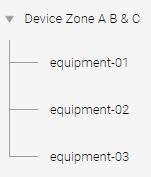Entities
Learn about entities
The Ardexa platform allow for data collection from on-site equipment connected to an Ardexa device. This equipment is shown on the platform as “sources”. The relationship between a device and its sources is rather simple: a two-level hierarchy where devices contain the collected sources.
While this model may be sufficient for basic data collection, it offers no flexibility, especially when it comes to relationships between different sources or devices. For example, some assets are divided into zones.
If the equipment from different zones is monitored using a single device, the out-of-the-box model wouldn’t be enough to separate the data depending on the zone.
In other cases, different zones may be monitored using different devices. In this scenario, it wouldn’t be possible to group the different zones under the same asset.
Regarding data visualization, different parties may be interested in structuring data in different ways. For example, a stakeholder may prefer to group assets in portfolios, with just enough depth to monitor production.
While a site operator may prefer to structure the data similarly to the actual layout of the asset, with layered and in-depth data about each individual piece of equipment.
You can overcome these limitations by using entities. In addition, combining entities with labels will allow you to easily configure dashboards and alerts for new assets seamlessly and with extra no effort.
In the following articles, you will learn how to create and edit entities to help you model your data in a way that makes sense to you and you desired outcomes.
Last updated





